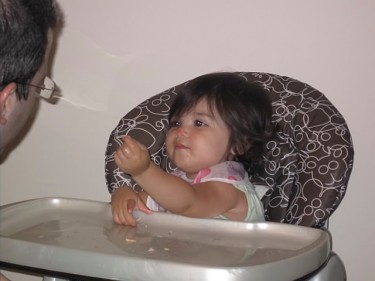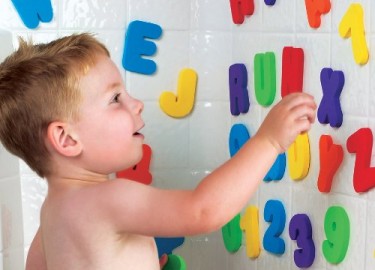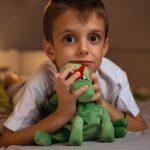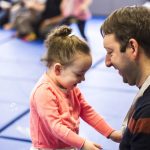By: Marni Weinberg, MA, CCC-SLP of Jumping Jax NYC
As a Speech Language Pathologist and Mommy of two, I have found it is easy to turn simple, every day activities into language-rich experiences. Let’s take a look at two activities I enjoy most with my little ones: dinnertime and bathtime.
Mealtime is a great opportunity to encourage sequencing skills as well as simple narrative skills. For example, as you prepare your child’s dinner, explain everything you are doing using child-friendly language. Look Julie: first Mommy takes the cucumber out of the refrigerator, then I peel the cucumber, next I cut the cucumber, and last Julie eats the cucumber! Even well before your child is able to understand the concept of sequence, she is watching you act as you narrate, and is slowly internalizing these sequential concepts (i.e., first, then, next, last). You can and should start an activity like this as early as infancy. Take a child who is only eating rice cereal: you can explain the steps involved in preparing the cereal, and then as you feed him, narrate the event. Look Brody: Mommy puts the spoon in the bowl, scoops some cereal on the spoon, and then the spoon flies to Brody’s mouth for you to eat!

If you’ll notice, I always start by calling the child’s attention to the action (Look Brody) so that I know he is watching my actions as I describe them. Additionally, I often interchange use of the child’s name with personal pronouns (e.g., I, you, etc.) to help the child understand the meaning and correct usage of these pronouns.
Mealtime is also a great opportunity to work on turn-taking skills. For example, once your child is able to pick up food, you can take turns feeding and eating. First Daddy is going to feed Julie and then Julie is going to feed Daddy. During these exchanges, make sure you encourage eye-contact by sitting at the child’s level so you can both easily look at each other. Additionally, you can narrate what each person does. Wow, Brody is picking up a blueberry and putting it in Mommy’s mouth-mmmmm delicious! During this simple activity, you are encouraging important components of conversational speech such as establishing and maintaining eye contact, turn-taking, sequencing, and narrative skills.
Once your child is done eating, the hands have been wiped, the face has been cleaned, and the food has been removed from your child’s hair (because let’s be honest- how often is it that your child does NOT put some part of dinner in his hair…), it’s time to take a bath. In order to smooth the transition from dinnertime to bathtime, I make sure to give a 2-minute warning. Something like: Soon dinner will be all done, and then we are going to take a bath. While undressing your child for the bath, it is easy to pair language with every action you take. Remember, the description doesn’t have to be (and shouldn’t be) overly wordy and descriptive- something as small and simple as arm out; head through; diaper off is perfect. By doing this, you are teaching and reinforcing knowledge of body parts, clothing, and prepositions.

My favorite bath toys are foam letters and numbers. Children go from squeezing and biting them to sticking them on the bath wall, to ordering them according to the alphabet, to putting them together in order to spell words. Throughout each of these stages of development, a parent can add to the play by teaching and reinforcing numerous basic concepts and skills. To name a few: number and letter names, letter sounds, number sequence, color names, prepositions (e.g., On the wall; In the water; etc.), and following directions (e.g., Put the number 5 next to the number 8; Take the letter A off the wall and put it into the water).
As during mealtime, narrate all your actions in the bath. My favorite song to use is the nursery rhyme, “This is the way,” to describe everything you do. This is the way we wash your hair… This is the way we clean your face… It’s a fun repetitive song that is easy for children to learn and then sing along. By singing this song, you are working on labeling body parts as well as simple verbs (e.g., wash; clean; etc.). I also like to give a 2-minute warning during bathtime to smooth the transition out of the bath and on to getting ready for bed.
During dinnertime and bathtime tonight, keep these easy tips in mind. Your child will not even realize you are “teaching” him important skills to help his communication skills develop and grow. Keep narrating the world to your child and don’t forget to have fun!!



